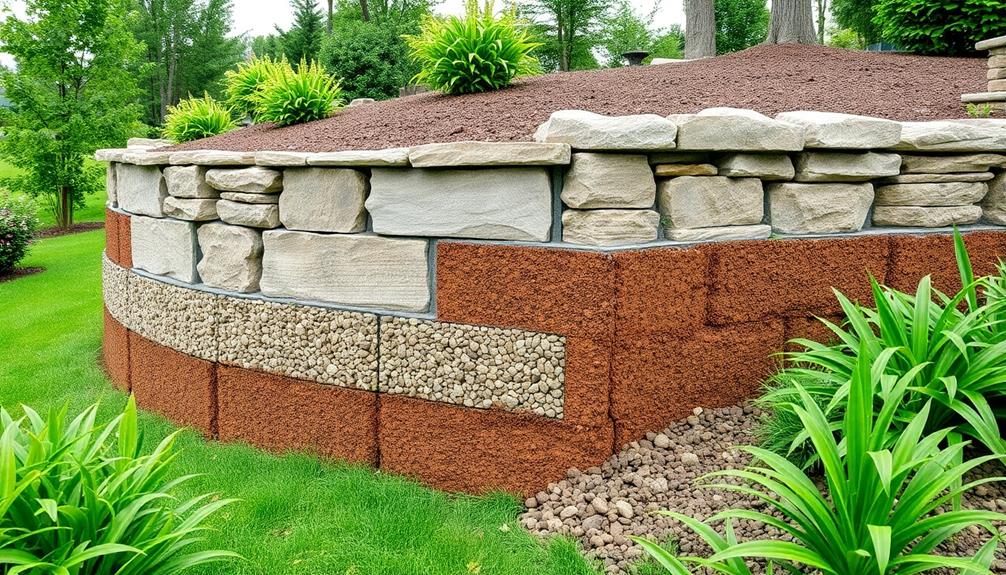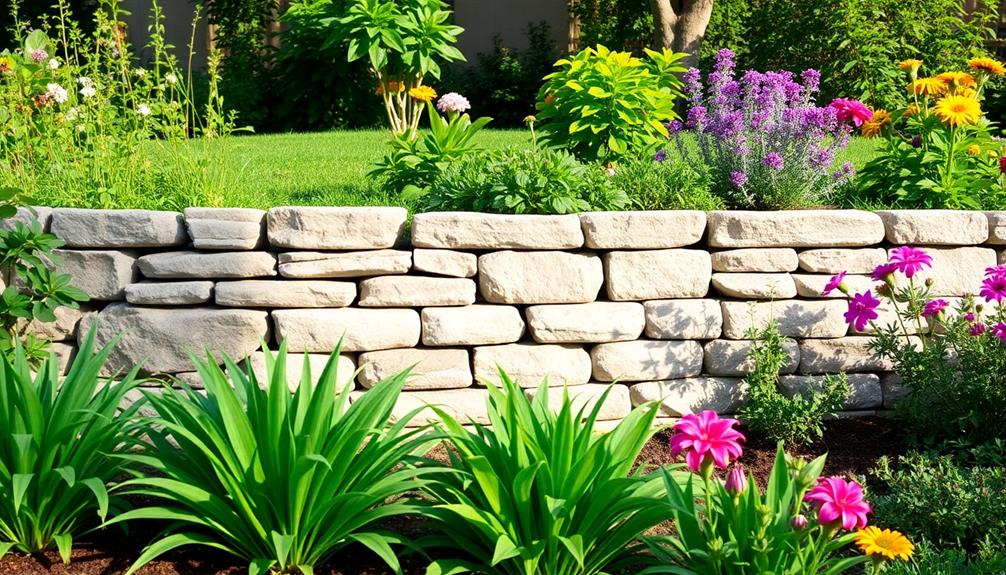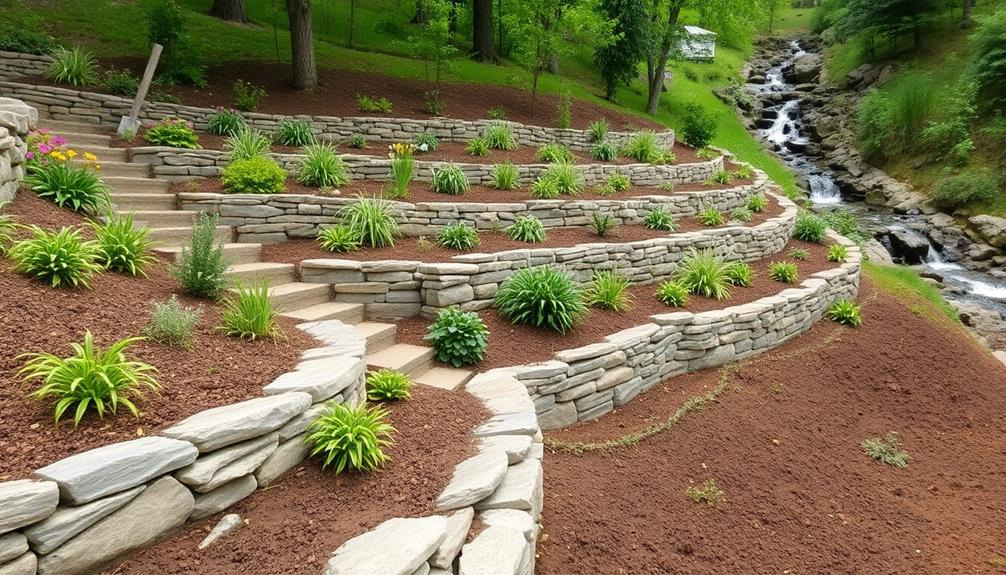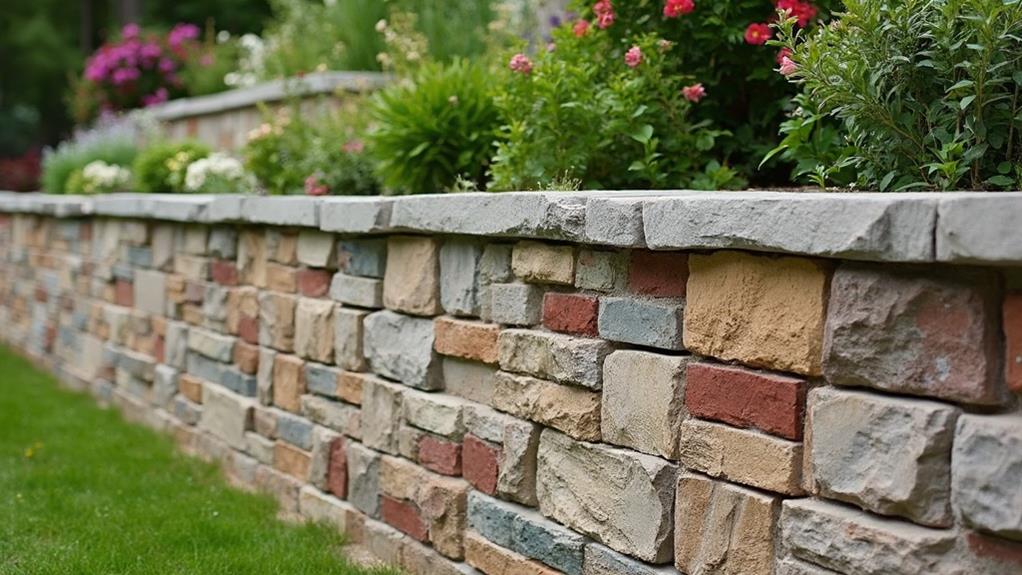Selecting the appropriate materials for your retaining wall is an essential component of landscape design, as it directly impacts the structure's effectiveness and longevity. Consider the specific geological characteristics of your site, such as soil type and slope, to determine the suitable material. Concrete blocks and poured concrete offer strength and uniform appearance, ideal for enduring the pressures of both soil and water. Natural stone adds a timeless aesthetic, providing robust support and blending with natural environments, while wood imparts versatility but may require more maintenance due to susceptibility to rot. Exploring material properties further reveals more about optimizing retaining wall performance.
Table of Contents
ToggleWalls Contractor Highlights
- Evaluate material durability and longevity based on local climate conditions and environmental factors.
- Consider the aesthetic appeal and design compatibility with the surrounding landscape.
- Assess the structural requirements to ensure the material can handle lateral earth and water pressures.
- Factor in the environmental impact, opting for eco-friendly, recycled, or renewable materials.
- Incorporate gravel drainage to manage water flow and maintain wall stability and durability.
Definition of Retaining Walls

Retaining walls serve a critical purpose in landscape architecture by providing necessary support to prevent soil erosion and manage water runoff, ultimately creating usable flat land on the uneven terrain. The installation of boulder retaining walls, for example, adds a natural and durable element to landscape designs.
These structures must meet specific structural requirements to withstand earth pressures and environmental conditions, which necessitates careful consideration of design and engineering principles. When it comes to material choices, options such as concrete, stone, and timber offer diverse characteristics and functionalities that align with both aesthetic preferences and structural demands, guiding the selection process based on the project's unique needs.
Purpose and Functionality
A retaining wall is a structural feature critical for providing lateral support to vertical or near-vertical slopes of soil. Its primary purpose is to prevent soil erosion, manage water runoff, and enhance land usability by stabilizing the landscape. By employing retaining walls, you can transform a hilly or uneven terrain into usable, aesthetically pleasing spaces that complement your home or community.
The functionality extends to protecting infrastructure, as it mitigates the risk of landslides, soil shifting, and other geotechnical issues that could jeopardize buildings or roads.
The essence of a retaining wall lies in its ability to withstand the lateral pressure exerted by soil, which can dramatically vary based on soil type, saturation levels, and external forces, such as traffic or seismic activity. For homeowners and community planners alike, recognizing the purpose and ensuring that a retaining wall functions effectively involves a careful consideration of its placement, height, and load-bearing capabilities.
Additionally, a thoughtfully constructed retaining wall fosters a sense of cohesion and harmony within a landscape, inviting residents and visitors to engage with a well-curated environment. Such walls not only serve practical needs but also contribute to the community's collective sense of belonging and security.
Structural Requirements
Understanding the structural requirements of retaining walls is paramount to their successful design and implementation. Fundamentally, a retaining wall serves the indispensable function of withstanding lateral earth pressures, holding back soil and preventing erosion and land movement in sloped terrains. Engineers and builders must verify these walls are designed to accommodate the forces exerted by soil weight, water pressure, and any additional loads or stresses from nearby structures or environmental conditions. Each retaining wall, whether installed in residential gardens or expansive commercial levels, must adhere to certain engineering principles to maintain structural integrity and performance over time.
Critical to this process is understanding the key components that contribute to a wall's strength and stability. This includes analyzing the wall's height, which influences the amount of pressure exerted upon it, and examining the foundation below the wall, which supports the wall under variable load conditions. Proper drainage systems are equally essential, as water accumulation behind the wall can drastically increase pressure and lead to structural failures. A thorough geotechnical investigation may be necessary to assess soil characteristics and ensure the project meets all relevant engineering and safety standards, fostering a sense of community trust and reliability.
Material Types Overview
Numerous materials are available for constructing retaining walls, each offering distinct properties that influence the wall's functionality, aesthetics, and longevity. The choice of material is fundamental, as it dictates how well the structure will blend with its environment and endure over time.
Commonly used materials include concrete blocks, poured concrete, natural stone, brick, wood, and gabion baskets, each presenting its unique advantages and considerations.
Concrete blocks are praised for their strength and uniform appearance, making them ideal for structurally demanding projects. Poured concrete offers a seamless look and formidable durability, though requiring proficient labor for installation.
Natural stone exudes timeless beauty, adapting well to any landscape while providing robust support. Brick retains its classic charm and aesthetic appeal, while its modular nature facilitates various design styles.
Wood offers versatility and warmth, well-suited for temporary or visually integrated walls, despite susceptibility to rot and insect damage. Gabion baskets, filled with stones or other materials, create a flexible and permeable structure, suitable for environmentally conscious designs.
Choosing the right material involves evaluating the specific needs of your project and the landscape's intrinsic character, ensuring a harmonious and enduring solution.
Benefits

When selecting materials for a retaining wall, several benefits underscore the importance of thoughtful consideration. Longevity and durability guarantee that the investment remains structurally sound over time, while the 'natural aspect of stone' offers a unique and alluring appeal.
Additionally, choosing materials like boulders for your retaining wall can lead to a long-term and cost-effective solution that holds ground effectively. Environmental impact considerations highlight the growing priority of eco-friendly solutions. Moreover, evaluating cost efficiency and aesthetic appeal provides an all-encompassing view of how these materials align with both budgetary constraints and design preferences.
Longevity and Durability
To guarantee lasting performance and structural integrity, selecting materials that offer longevity and durability is essential when building a retaining wall. The choice of materials not only determines the wall's lifespan but also its ability to withstand various environmental pressures over time. By ensuring a foundation built on resilient materials, one secures peace of mind and a sense of belonging in a community that values workmanship and sustainability.
Considering the following factors can guide you in making an informed decision:
- Material Composition: Opt for materials like concrete blocks, stone, or brick, known for their robustness and ability to withstand external stressors.
- Resistance to Climate: Select materials that perform well under the specific climatic conditions of your area, such as resisting moisture, freeze-thaw cycles, and UV exposure.
- Maintenance Requirements: Choose materials that require minimal upkeep, ensuring that the wall remains structurally sound with little intervention over the years.
- Reputation for Endurance: Engage with experts or consult historical examples in your locale to choose materials with a proven track record of longevity.
Ultimately, by thoughtfully selecting materials that excel with respect to durability, you're investing in a structure that will stand the test of time, reinforcing your place within a community that understands and cherishes enduring quality.
Environmental Impact Consideration
Considering the environmental impact of retaining wall materials bolsters sustainable construction practices and promotes ecological balance. In today's world, choosing eco-friendly materials fosters a sense of responsible stewardship among communities, intertwining individual efforts with global environmental goals.
Selecting materials like locally sourced stones or recycled concrete bars reduces carbon footprints by minimizing transportation emissions and conserving natural resources. Additionally, utilizing permeable materials supports groundwater recharge by allowing water passage, consequently nurturing local ecosystems and enhancing biodiversity.
Material choice also encompasses the lifecycle implications of construction materials. Opting for biodegradable or recyclable options guarantees that deconstructed walls do not contribute to landfill waste, fostering a complete, circular economy. By embracing natural materials such as timber, practitioners support carbon sequestration and storage, further mitigating potential climate change impacts.
Likewise, the incorporation of native vegetation alongside retaining structures contributes additional ecological benefits, such as habitat creation and erosion control.
Cost Efficiency Analysis
How do material choices impact the cost efficiency of retaining wall construction? The selection of materials is integral to ensuring that a retaining wall not only serves its functional purpose but also aligns with budgetary constraints. By opting for materials that balance durability, availability, and installation ease, builders can drastically reduce overall expenses and extend the lifespan of the wall, thereby maximizing cost efficiency.
When deliberating on material options, consider the following factors:
- Durability: Long-lasting materials like reinforced concrete or stone can mitigate frequent repair costs, although initial investment might be higher.
- Availability: Locally sourced materials can cut down on transportation costs, benefiting both the environment and your budget.
- Ease of Installation: Certain prefabricated material systems can reduce labor costs due to simpler and faster assembly processes.
- Maintenance Requirements: Materials with low maintenance needs, such as treated timber or interlocking blocks, often lead to reduced long-term maintenance expenses.
Each of these factors contributes to a holistic analysis where the savings generated from efficient material selection become evident over time. A thoughtful decision not only reflects a commitment to economic stewardship but also fosters a sense of belonging within a community that values both practical and sustainable construction practices.
Aesthetic Appeal Factors
While choosing materials for a retaining wall, aesthetic appeal serves as a pivotal factor, offering numerous benefits that extend beyond mere functionality. Beyond its structural role, a well-executed retaining wall can transform a mundane landscape into an engaging visual experience, fostering a sense of pride and belonging within the community. Material choices such as natural stone, wood, or concrete provide a variety of textures, colors, and finishes that can harmonize with existing architectural elements and natural surroundings, creating a cohesive, serene environment that resonates with residents and visitors alike.
When considering the aesthetic impact, it is essential to evaluate not only the initial appearance but also how the materials will age over time. For instance, weathered stones and timber can enhance the rustic charm of an outdoor space, while sleek, polished materials may suit more contemporary settings. Additionally, thoughtful lighting integration can highlight the architectural beauty of the wall during the evening, extending its visual appeal and utility. Ultimately, by prioritizing aesthetic qualities in material selection, you contribute to an inviting, attractive landscape that nurtures a strong sense of community belonging and elevates the quality of the living environment for all stakeholders involved.
Soil Erosion Control Solutions

Effective soil erosion control is integral not only for the longevity of retaining walls but also for the environmental sustainability of the surrounding areas. Utilizing solutions such as natural vegetation barriers, geotextile fabric layers, and gravel drainage systems can tremendously enhance the stability and efficiency of retaining walls. Below is an overview of these methods, highlighting key aspects of each:
| Solution | Benefits | Considerations |
|---|---|---|
| Natural Vegetation Barriers | Aids in soil stabilization and absorbs moisture | Requires regular maintenance |
| Geotextile Fabric Layers | Offers separation and filtration benefits | Initial installation complexity |
| Gravel Drainage Systems | Facilitates water removal to prevent pressure | Needs careful design and execution |
| Erosion Control Blankets | Reduces runoff velocity and surface erosion | Temporary until vegetation grows |
| Retaining Wall Terraces | Mitigates slope steepness for better control | May require structural expertise |
Natural Vegetation Barriers
Natural vegetation barriers serve as an essential component in soil erosion control solutions, particularly for retaining walls. These barriers capitalize on the inherent strength and interlocking root systems of various plant species to stabilize soil and prevent erosion. By integrating natural vegetation into your retaining wall's design, you not only enhance the structural integrity of the wall but also contribute to the aesthetic appeal of the surrounding environment. Vegetation selections should consider local plant species known for their erosion control properties, fostering a sense of regional belonging and ecosystem integration.
Utilizing vegetation as a barrier offers several advantages:
- Biodiversity Enhancement: Introducing native plants can boost local biodiversity, promoting ecological sustainability.
- Improved Soil Stability: The root systems of plants hold soil in place, reducing the likelihood of soil displacement and erosion.
- Aesthetic Value: Natural vegetation softens the visual impact of retaining walls, blending them into the landscape seamlessly.
- Environmental Benefits: Plants contribute to cleaner air and potentially create habitats for local wildlife, improving the overall ecosystem health.
When planning for natural vegetation barriers, careful selection and strategic placement can extensively augment your retaining wall's durability while fostering a sustainable and harmonious connection with the land.
Geotextile Fabric Layers
Geotextile fabric layers offer a sophisticated solution within the domain of soil erosion control for retaining walls. These fabrics, engineered from high-quality polymers, are adept at stabilizing soil while allowing water passage, serving to reduce hydrostatic pressure, a critical factor in soil management. They integrate seamlessly with the aesthetics of retaining wall systems, enhancing both function and longevity. By carefully interweaving these layers between soil and fill material, they provide a stabilizing effect that mitigates erosion and ground movement, ensuring your retaining wall maintains its structural integrity over time.
Incorporating geotextile fabrics aligns with a community of environmentally conscious builders and homeowners who value sustainability and engineering excellence. These fabrics run the gamut from non-woven types, which provide filtration and drainage capabilities, to woven types, which offer greater tensile strength. The selection between these fabric types depends principally on specific site conditions, such as soil composition and expected water flow, both critical considerations in retaining wall design. Embracing geotextile fabric layers in your retaining wall construction reflects a commitment to a sustainable methodology that resonates with those who prioritize earth-friendly solutions without compromising on modern construction standards.
Gravel Drainage Systems
At the core of effective soil erosion control for retaining walls lies the implementation of gravel drainage systems. These systems not only fortify the structural integrity of retaining walls but also efficiently manage water flow, preventing erosion and undermining of soil structures. Gravel allows for the free movement of water, reducing hydrostatic pressure against the wall and ensuring longer-lasting stability. By creating an underlying drainage system composed of gravel, you help shield your retaining wall against the disruptive forces of water.
A well-constructed gravel drainage system can yield the following benefits:
- Optimal Water Management: Gravel aids in directing water away from the wall, preventing buildup that could compromise the wall's stability.
- Durability Enhancement: Lowering water pressure reduces wear and tear, extending the lifespan of the retaining wall.
- Minimal Maintenance: Gravel systems require less frequent maintenance, offering convenience and peace of mind.
- Ecological Balance: By mitigating erosion, gravel drainage helps maintain local ecosystems, preserving the surrounding environment.
Incorporating gravel drainage systems into your retaining wall strategy demonstrates a shared commitment to safeguarding our collective environment. This understanding not only strengthens communal ties but also underscores the importance of sustainable construction practices that benefit everyone.
Walls Contractor FAQ
What Factors Determine the Best Material for a Retaining Wall?
Selecting a fitting material for a retaining wall is influenced by factors like soil type, drainage requirements, wall height, budget, and aesthetic preferences. Such considerations guarantee the structure's longevity, functionality, and harmony within its surroundings.
How Do Climate and Weather Conditions Affect Material Choice?
Climate and weather conditions profoundly influence material selection, with factors like rainfall, freeze-thaw cycles, and temperature fluctuations dictating durability and maintenance needs. Choosing materials resilient to local climate secures longevity and efficacy of the retaining structure.
What Is the Cost Comparison Between Different Retaining Wall Materials?
When evaluating retaining wall materials, consider cost variations: concrete is typically more expensive than wood, while natural stone or brick can further elevate costs. Balance budget with performance to guarantee a durable, aesthetically pleasing solution that meets community standards.
What Are the Environmental Impacts of Various Retaining Wall Materials?
The environmental impacts of retaining wall materials vary, with concrete typically having a higher carbon footprint, while timber may result in deforestation. Eco-friendly options include recycled materials or local stone, potentially reducing environmental harm and fostering sustainable practices.
How Do Maintenance Requirements Vary Between Retaining Wall Materials?
Retaining wall materials have diverse maintenance needs; timber may necessitate frequent treatments against rot, while concrete requires minimal upkeep but periodic inspection for cracks. Stone, although durable, demands regular re-pointing to maintain structural integrity and aesthetics.







